The Effect of Soundscapes and Lightscapes on the Perception of Safety and Social Presence Analyzed in a Laboratory Experiment
Abstract
1. Introduction
1.1. Soundscape and Safety Perception
1.2. Lightscape and Safety Perception
1.3. Simulated Test Environments and Audio-Visual Interaction
1.4. Objectives of the Study
2. Materials and Methods
2.1. Case-Study
2.2. Lightscape Simulations
2.3. Soundscape Simulations
2.4. Test Structure
2.5. Experimental Setup
3. Results and Discussions
3.1. Principal Component Analysis
3.2. Effects of the Music and Lighting Conditions on Perceived Safety and Perceived Social Presence
3.3. Strengths and Limitations of the Study
4. Conclusions
Author Contributions
Funding
Conflicts of Interest
References
- Ferrando, D.T. La città come. Storia dell’idea di paesaggio urbano; Politecnico di Torino: Turin, Italy, 2012. [Google Scholar]
- Cullen, G. Townscape; Reinhold Pub. Corp.: New York, NY, USA, 1961. [Google Scholar]
- Lynch, K. The Imafe of the City; MIT Press: Cambridge, MA, USA, 1960. [Google Scholar]
- Lynch, K.; Hack, G. Site Planning; MIT Press: Cambridge, MA, USA, 1962. [Google Scholar]
- Banerjee, T.; Southworth, M. City Sense and City Design. Writings and projects of Kevin Lynch; MIT Press: Cambridge, MA, USA, 1990. [Google Scholar]
- Radicchi, A. Sull’ Immagine Sonora Della Città; Firenze University Press: Firenze, Italy, 2012. [Google Scholar]
- Southworth, M. The Sonic Environment of Cities. Environ. Behav. 1969, 1, 49–70. [Google Scholar]
- Rogerson, R.; Rice, G. Making sense of places: “Moral geographies” of sensory urbanism. Archit. Theory Rev. 2009, 14, 142–155. [Google Scholar] [CrossRef]
- Shi, S.; Gou, Z.; Chen, L.H.C. How does enclosure influence environmental preferences? A cognitive study on urban public open spaces in Hong Kong. Sustain. Cities Soc. 2014, 13, 148–156. [Google Scholar] [CrossRef]
- Schipperijn, J.; Ekholm, O.; Stigsdotter, U.K.; Toftager, M.; Bentsen, P.; Kamper-Jørgensen, F.; Randrup, T.B. Factors influencing the use of green space: Results from a Danish national representative survey. Landsc. Urban Plan. 2010, 95, 130–137. [Google Scholar] [CrossRef]
- Xue, F.; Gou, Z.; Lau, S.S.Y. Green open space in high-dense Asian cities: Site configurations, microclimates and users’ perceptions. Sustain. Cities Soc. 2017, 34, 114–125. [Google Scholar] [CrossRef]
- Radicchi, A.; Henckel, D. Combined Sound- & Lightwalks. A perception based method to analyze and evaluate the sonic and light environment of our cities at night. In Proceedings of the Euronoise, Heraklion, Greece, 27–31 May 2018. [Google Scholar]
- Newman, O. Defensible Space: Crime Prevention Through Urban Design; MacMillan Publishing Company: Basingstoke, UK, 1973. [Google Scholar]
- D’Alessandro, F.; Evangelisti, L.; Guattari, C.; Grazieschi, G.; Orsini, F. Influence of soundscape and other features on the soundscape assessment of a university external area. Build. Acoust. 2018, 25, 199–217. [Google Scholar] [CrossRef]
- Abu-Ghazzeh, T.M. Communicating behavioral research to campus design factors affecting the perception and use of outdoor spaces at the University of Jordan. Environ. Behav. 1999, 31, 764–804. [Google Scholar] [CrossRef]
- Aletta, F.; Lepore, F.; Kostara-Konstantinou, E.; Kang, J.; Astolfi, A. An Experimental Study on the Influence of Soundscapes on People’s Behaviour in an Open Public Space. Appl. Sci. 2016, 6, 276. [Google Scholar] [CrossRef]
- Astolfi, A.; Orecchia, P.; Bo, E.; Shtrepi, L.; Calleri, C.; Aletta, F. Influence of Soundscapes on Perception of Safety and Social Presence in an Open Public Space. In Handbook of Research on Perception-Driven Approaches to Urban Assessment and Design; Aletta, F., Xiao, J., Eds.; IGI Global: Hershey, PA, USA, 2018; pp. 126–149. [Google Scholar]
- Wu, S. Investigating Lighting Quality: Examining the Relationship between Pedestrian Lighting environment and Perceived Safety. Master’s Thesis, Virginia Tech University, Blacksburg, VA, USA, 2014. [Google Scholar]
- Milliman, R.E. Using Background Affect to Music Behavior of the Supermarket Shoppers. J. Mark. 1982, 46, 86–91. [Google Scholar] [CrossRef]
- Lesiuk, T. The effect of music listening on work performance—Lesiuk 33 (2): 173—Psychology of Music. Psychol. Music 2005, 33, 173–191. [Google Scholar] [CrossRef]
- International Organization for standardization ISO 12913-1:2014 Acoustics—Soundscape—Part 1: Definition and conceptual framework. Available online: https://www.iso.org/standard/52161.html (accessed on 25 October 2018).
- International Organization for Standardization ISO/TS 12913-2:2018 Acoustics—Soundscape—Part 2: Data collection and reporting requirements 2018. Available online: https://www.iso.org/standard/75267.html (accessed on 25 October 2018).
- Kang, J.; Aletta, F.; Gjestland, T.T.; Brown, L.A.; Botteldooren, D.; Schulte-Fortkamp, B.; Fiebig, A.; Bento Coelho, J.L.; Lercher, P.; van Kamp, I.; et al. Ten questions on the soundscapes of the built environment. Build. Environ. 2016, 108, 284–294. [Google Scholar] [CrossRef]
- Yang, W.; Kang, J. Soundscape and sound preferences in urban squares: A case study in Sheffield. J. Urban Des. 2005, 10, 61–80. [Google Scholar] [CrossRef]
- Yu, L.; Kang, J. Effects of social, demographical and behavioral factors on the sound level evaluation in urban open spaces. J. Acoust. Soc. Am. 2008, 123, 772–783. [Google Scholar] [CrossRef] [PubMed]
- Bild, E.; Coler, M.; Wörtche, H. Habitats Assen Pilot: Testing Methods for Exploring the Correlation between Sound, Morphology and Behavior. In Proceedings of the Measuring Behavior, Wageningen, The Netherlands, 27–29 August 2014. [Google Scholar]
- Steele, D.; Steffens, J.; Guastavino, C. The role of activity in urban soundscape evaluation. In Proceedings of the EuroNoise, Maastricht, The Netherlands, 31 May–3 June 2015. [Google Scholar]
- Steffens, J.; Steele, D.; Guastavino, C. Situational and person-related factors influencing momentary and retrospective soundscape evaluations in day-to-day life. J. Acoust. Soc. Am. 2017, 141, 1414–1425. [Google Scholar] [CrossRef] [PubMed]
- Lavia, L.; Easteal, M.; Close, D.; Witchel, H.; Axelsson, O.; Ware, M.; Dixon, M. Sounding Brighton: soundscapes practical approaches towards better. In Proceedings of the Internoise, New York, NY, USA, 19–22 August 2012; pp. 4544–4552. [Google Scholar]
- Easteal, M.; Bannister, S.; Kang, J.; Aletta, F.; Lavia, L.; Witchel, H. Urban Sound Planning in Brighton and Hove. In Proceedings of the Forum Acusticum, Krakow, Poland, 7–12 September 2014. [Google Scholar]
- Lavia, L.; Witchel, H.J.; Kang, J.; Aletta, F. A preliminary soundscape management model for added sound in public spaces to discourage anti-social and support pro-social effects on public behaviour Spaces to Discourage Anti-social and Support Pro-social Effects on Public Behaviour. In Proceedings of the DAGA, Aachen, Germany, 14–17 March 2016; pp. 1339–1342. [Google Scholar]
- Schafer, T.; Huron, D.; Shanahan, D.; Sedlmeier, P. The sounds of safety: Stress and danger in music perception. Front. Psychol. 2015, 6, 1–9. [Google Scholar] [CrossRef] [PubMed]
- Sayin, E.; Krishna, A.; Ardelet, C.; Briand Decré, G.; Goudey, A. “Sound and safe”: The effect of ambient sound on the perceived safety of public spaces. Int. J. Res. Mark. 2015, 32, 343–353. [Google Scholar] [CrossRef]
- Cozens, P.M.; Neale, R.H.; Whitaker, J.; Hillier, D.; Graham, M. A Critical Review of Street Lighting, Crime and the Fear of Crime in the British City in 2003. Crime Prev. Community Safe 2003, 5, 7–24. [Google Scholar] [CrossRef]
- Tien, J.M.; Donnell, V.F.O.; Barnett, A.I.; Mirchandani, P.B. Street lighting projects. National Evaluation Program, Phase 1 Summary Report; US Dept. of Justice NIJ: Washington, DC, USA, 1977. [Google Scholar]
- Peña-García, A.; Hurtado, A.; Aguilar-Luzón, M.C. Impact of public lighting on pedestrians’ perception of safety and well-being. Saf. Sci. 2015, 78, 142–148. [Google Scholar] [CrossRef]
- Welsh, B.P.; Farrington, D.P. Effects of Improved Lighting on Crime. 2008. Available online: http://mws-73973.mws3.csx.cam.ac.uk/people/academic_research/david_farrington/light.pdf (accessed on 27 May 2019).
- Fotios, S.; Unwin, J.; Farrall, S. Road lighting and pedestrian reassurance after dark: A review. Light. Res. Technol. 2015, 47, 449–469. [Google Scholar] [CrossRef]
- Boyce, P.R.; Eklund, N.H.; Hamilton, B.J.; Bruno, L.D. Perceptions of safety at night in different lighting conditions. Light. Res. Technol. 2000, 32, 79–91. [Google Scholar] [CrossRef]
- Van Bommel, W.J.M.; Caminada, E. Considerations of the lighting of residential areas for non-motorised traffic. In Proceedings of the CIBSE National Lighting Conference, Warwick, UK, 8–11 June 1982. [Google Scholar]
- Nikunen, H.; Korpela, K.M. The effects of scene contents and focus of light on perceived restorativeness, fear and preference in nightscapes. J. Environ. Plan. Manag. 2012, 55, 453–468. [Google Scholar] [CrossRef]
- Cellucci, L.; Bisegna, F.; Gugliermetti, F.; Navvab, M. Lighting distribution affects pedestrians’ sense of security. In Proceedings of the EEEIC 2016—International Conference on Environment and Electrical Engineering, Florence, Italy, 6–8 June 2016; pp. 1–5. [Google Scholar]
- Boomsma, C.; Steg, L. Feeling Safe in the Dark. Environ. Behav. 2012, 46, 193–212. [Google Scholar] [CrossRef]
- Raynham, P.; Saksvikrønning, T. White light and facial recognition. Light. J. 2003, 68, 29–33. [Google Scholar]
- Di Stefano, M. Lightscape e percezione dello spazio urbano: il caso del Concourse bridge a Sheffield, Politecnico di Torino. 2017. Available online: https://webthesis.biblio.polito.it/6159/ (accessed on 25 October 2018).
- Calleri, C.; Astolfi, A.; Pellegrino, A.; Orecchia, P.; Di Stefano, M.; Bo, E.; Shtrepi, L.; Aletta, F. On the influence of soundscape and lightscape design of public spaces on safety and social presence perception. In Proceedings of the 8th International Symposium on Temporal Design, Bologna, Italy, 14–15 September 2017. [Google Scholar]
- Lombard, M.; Ditton, T. At the Heart of It All: The Concept of Presence. J. Comput. Commun. 1997, 3. [Google Scholar] [CrossRef]
- Biocca, F.; Harms, C.; Burgoon, J.K. Towards A More Robust Theory and Measure of Social Presence: Review and Suggested Criteria. Presence Teleoperators Virtual Environ. 2003, 12, 456–480. [Google Scholar] [CrossRef]
- Warr, M. Dangerous Situations: Social Context and Fear of Victimization. Soc. Forces 1990, 68, 891–907. [Google Scholar] [CrossRef]
- Mikulincer, M.; Shaver, P.R.; Pereg, D. Attachment Theory and Affect Regulation: The Dynamics, Development, and Cognitive Consequences of Attachment-Related Strategies. Motiv. Emot. 2003, 27, 77–102. [Google Scholar] [CrossRef]
- Viollon, S.; Lavandier, C.; Drake, C. Influence of visual setting on sound ratings in an urban environment. Appl. Acoust. 2002, 63, 493–511. [Google Scholar] [CrossRef]
- Pheasant, R.; Horoshenkov, K.; Watts, G.; Barrett, B. The acoustic and visual factors influencing the construction of tranquil space in urban and rural environments tranquil spaces-quiet places? J. Acoust. Soc. Am. 2008, 123, 1446–1457. [Google Scholar] [CrossRef]
- Preis, A.; Kociński, J.; Hafke-Dys, H.; Wrzosek, M. Audio-visual interactions in environment assessment. Sci. Total Environ. 2015, 523, 191–200. [Google Scholar] [CrossRef]
- Maffei, L.; Iachini, T.; Masullo, M.; Aletta, F.; Sorrentino, F.; Senese, V.P.; Ruotolo, F. The effects of vision-related aspects on noise perception of wind turbines in quiet areas. Int. J. Environ. Res. Public Health 2013, 10, 1681–1697. [Google Scholar] [CrossRef]
- Maffei, L.; Masullo, M.; Aletta, F.; Di Gabriele, M. The influence of visual characteristics of barriers on railway noise perception. Sci. Total Environ. 2013, 445–446, 41–47. [Google Scholar] [CrossRef]
- Nasar, J.L. Assessing Perceptions of Environments for Active Living. Am. J. Prev. Med. 2008, 34, 357–363. [Google Scholar] [CrossRef]
- Bishop, I.D.; Rohrmann, B. Subjective responses to simulated and real environments: A comparison. Landsc. Urban Plan. 2003, 65, 261–277. [Google Scholar] [CrossRef]
- European Standardization Organization EN 13201-3: 2015—Road lighting—Part 3: Calculation of performance 2015. Available online: https://shop.bsigroup.com/ProductDetail/?pid=000000000030266811 (accessed on 25 October 2019).
- Aletta, F.; Kang, J. Towards an Urban Vibrancy Model: A Soundscape Approach. Int. J. Environ. Res. Public Health 2018, 15, 1712. [Google Scholar] [CrossRef]
- Tang, J.; Long, Y. Measuring visual quality of street space and its temporal variation: Methodology and its application in the Hutong area in Beijing. Landsc. Urban Plan. 2018. [Google Scholar] [CrossRef]
- Salesses, P.; Schechtner, K.; Hidalgo, C.A. The Collaborative Image of The City: Mapping the Inequality of Urban Perception. PLoS ONE 2013, 8. [Google Scholar] [CrossRef]
- Christensen, C.L.; Koutsouris, G. Odeon Room Acoustic Software, Version 13, Full User’s Manual. Odeon A/S, Lyngby (DK). 2016. Available online: http://www.odeon.dk/download/Version13/ODEONManual.pdf (accessed on 25 October 2018).
- Ciullo, P. Soundscape and behavioural effects of introduced music in the acoustic environment: A field experiment. Politecnico di Torino, Turin (IT). 2016. Available online: https://webthesis.biblio.polito.it/4634/ (accessed on 25 October 2018).
- International Organization for standardization ISO 3382-1:2009 Acoustics—Measurements of room acoustic parameters—Part 1: performance spaces 2009. Available online: https://www.iso.org/standard/40979.html (accessed on 25 October 2019).
- Paini, D.; Rindel, J.H.; Gade, A.C.; Turchini, G. The acoustics of public squares/places: a comparison between results from a computer simulation program and measurements in situ. Proc. Inter-Noise 2004, 66, 1–8. [Google Scholar]
- Thomas, P.; Van Renterghem, T.; Botteldooren, D. Using room acoustical parameters for evaluating the quality of urban squares for open-air rock concerts. Appl. Acoust. 2011, 72, 210–220. [Google Scholar] [CrossRef][Green Version]
- Iannace, G. The use of historical courtyards for musical performances. Build. Acoust. 2016, 23, 1–16. [Google Scholar] [CrossRef]
- British Standard BS 8233: 1999 Sound insulation and noise reduction for buildings—Code of practice 1999; British Standards Institution: London, UK.
- Kaiser, H.F. The application of electronic computers to factor analysis. Educ. Psychol. Meas. 1960, 20, 141–151. [Google Scholar] [CrossRef]
- Cattel, R. The scree test for the number of factors. Multivariate Behav. Res. 1966, 1, 245–276. [Google Scholar] [CrossRef]
- Thurstone, L.L. Multiple factor analysis; University of Chicago Press: Chicago, IL, USA, 1947. [Google Scholar]
- Maffei, L.; Masullo, M.; Pascale, A.; Ruggiero, G.; Romero, V.P. Immersive virtual reality in community planning: Acoustic and visual congruence of simulated vs real world. Sustain. Cities Soc. 2016, 27, 338–345. [Google Scholar] [CrossRef]

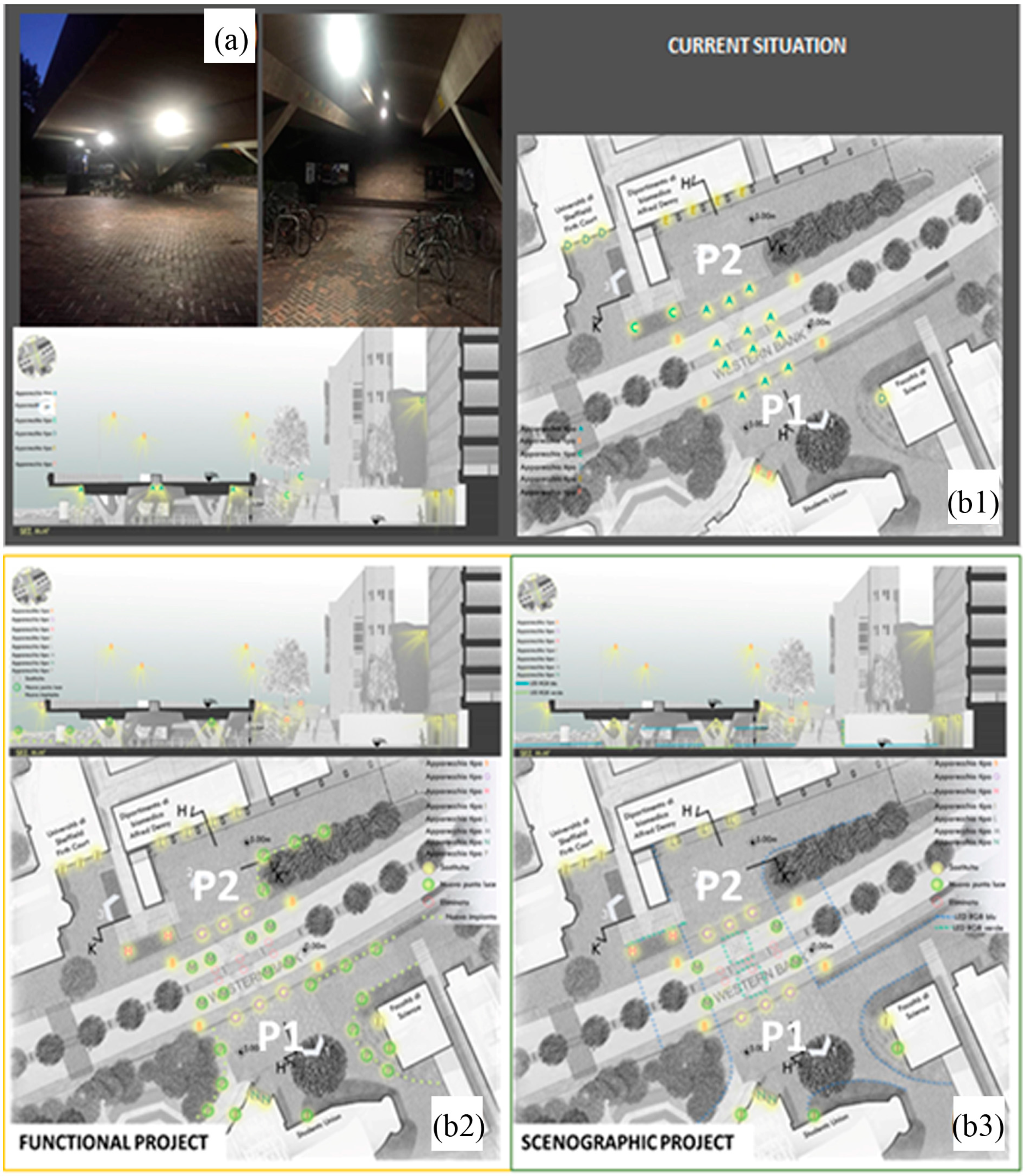
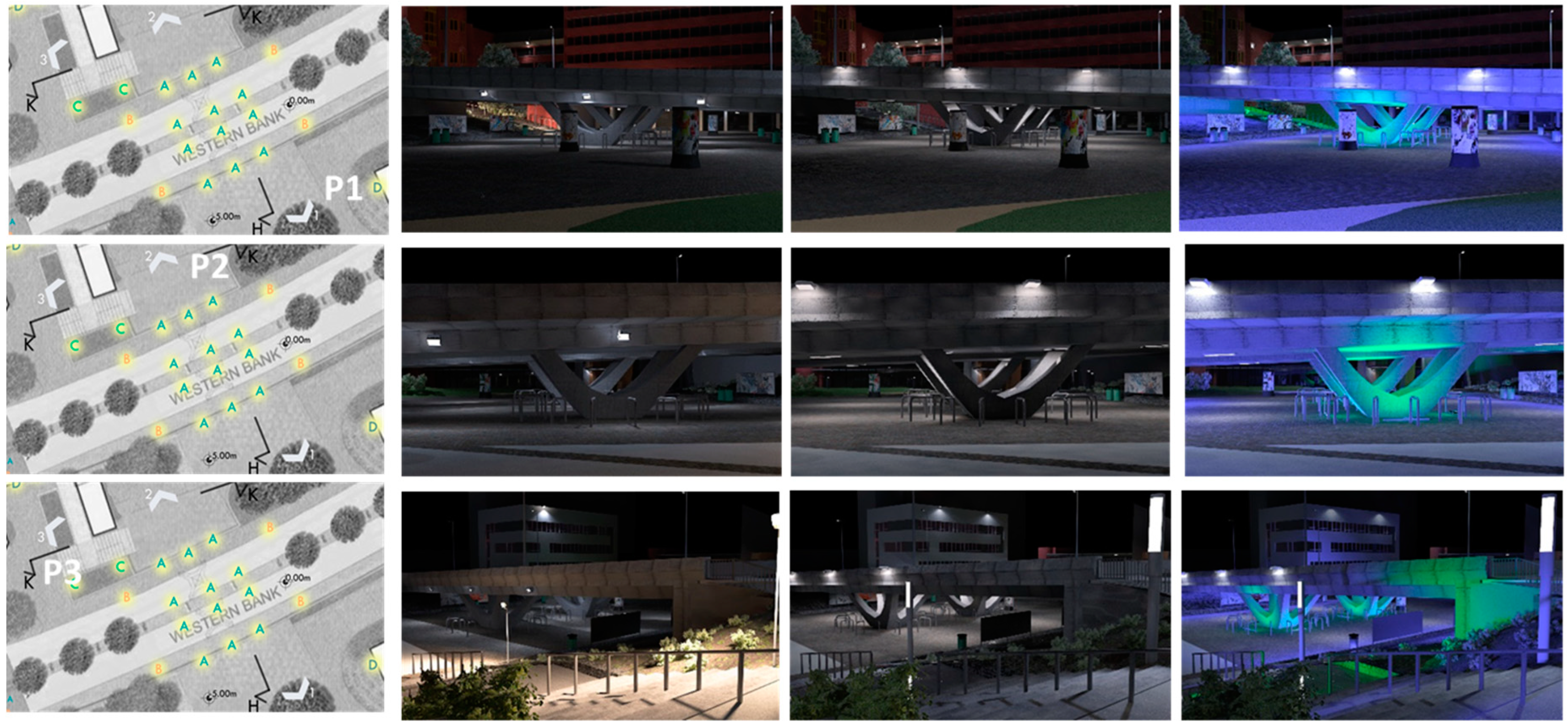
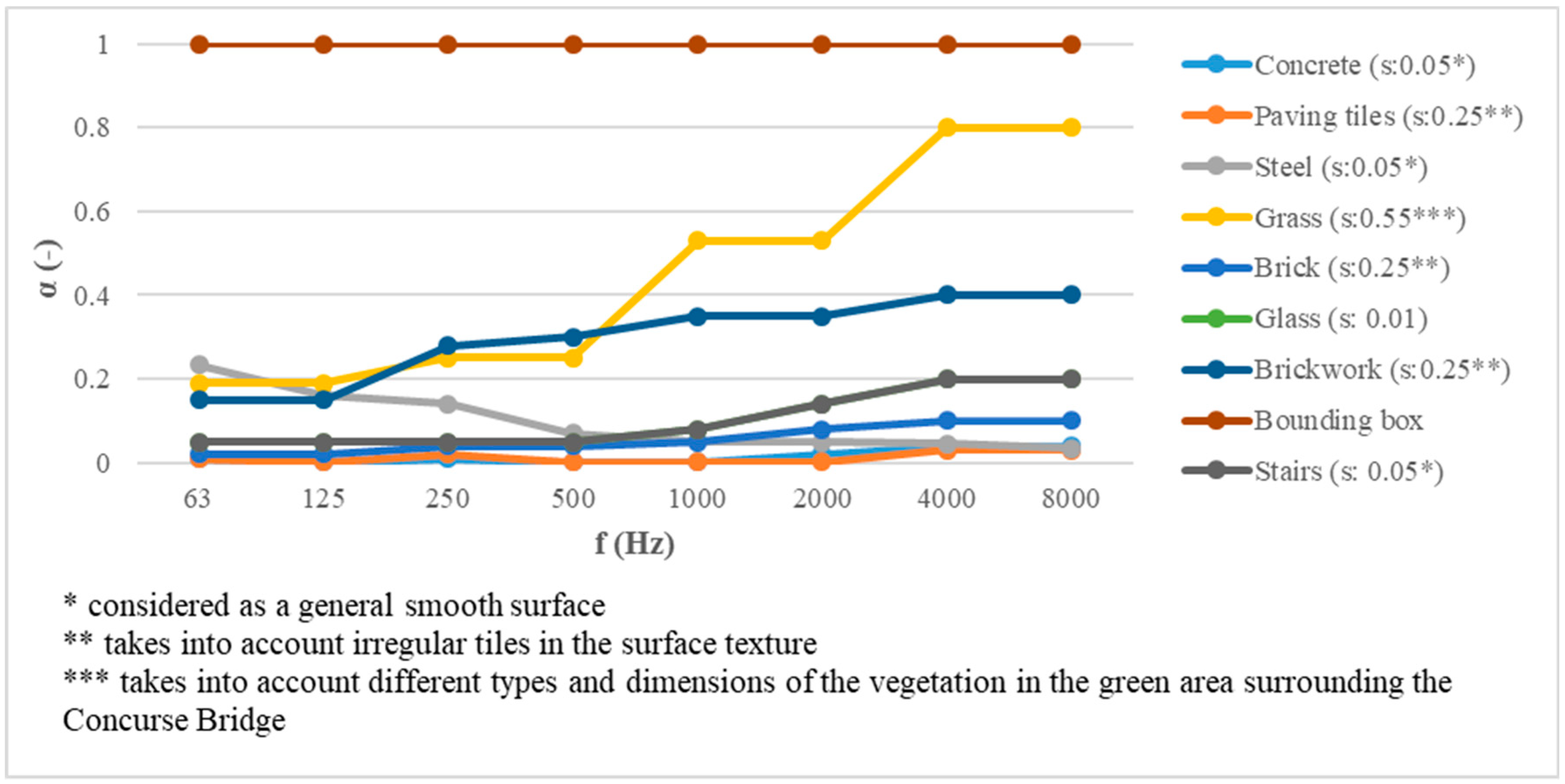

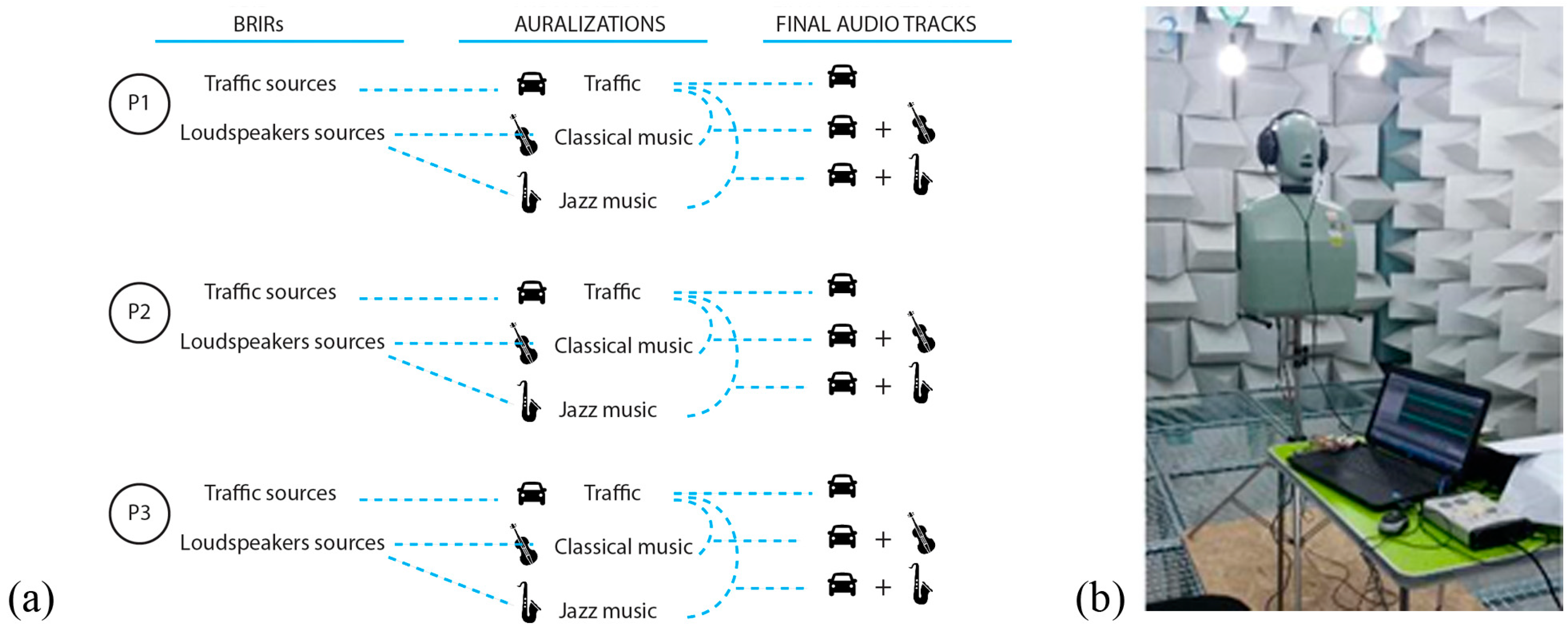
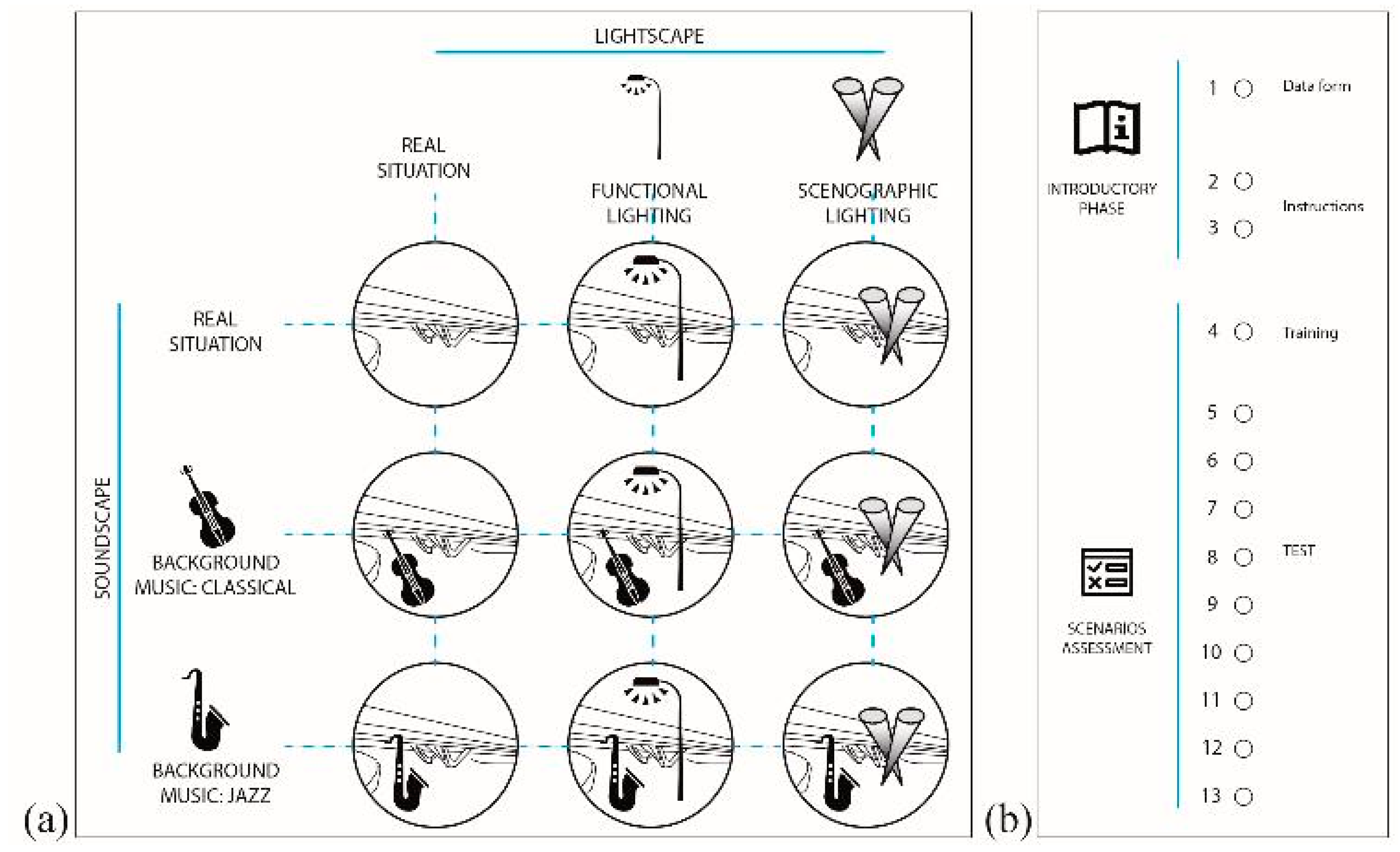
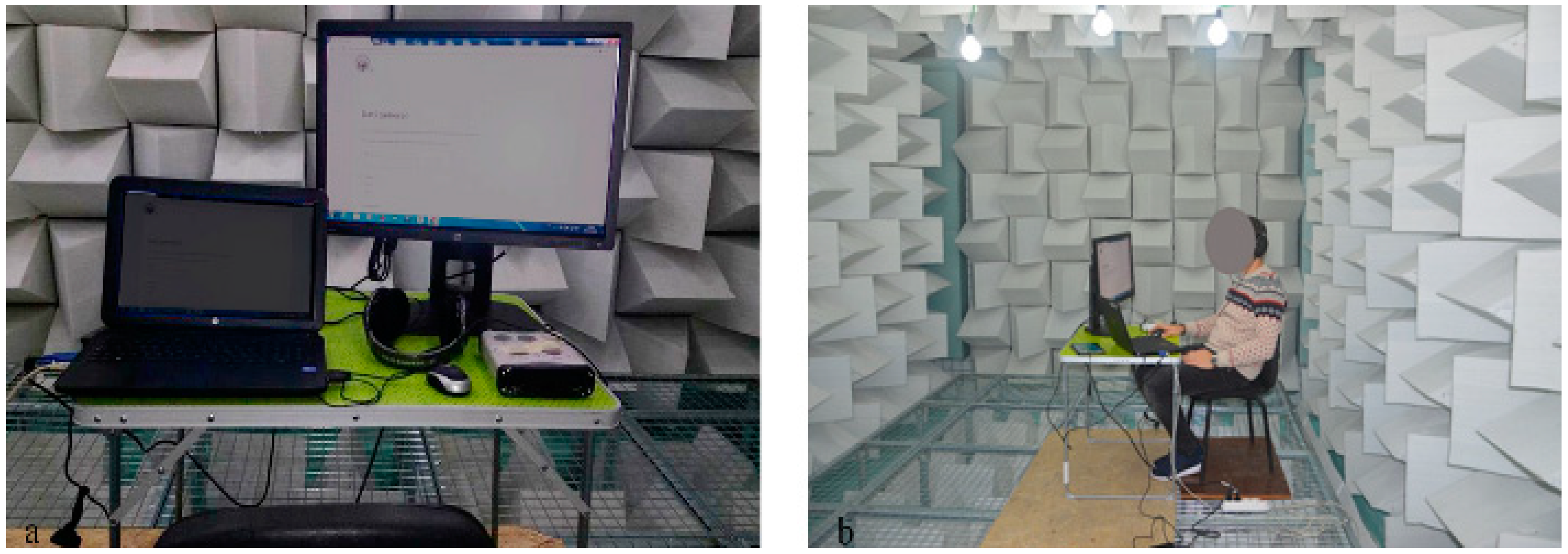
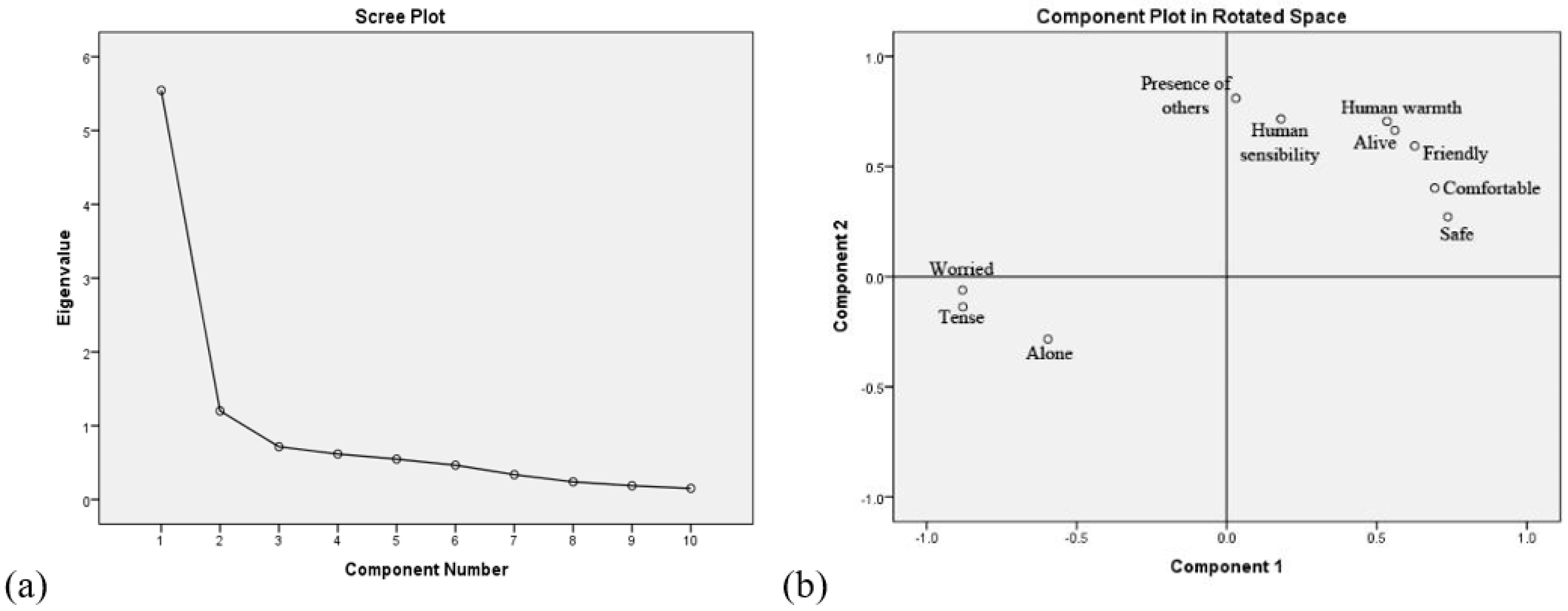

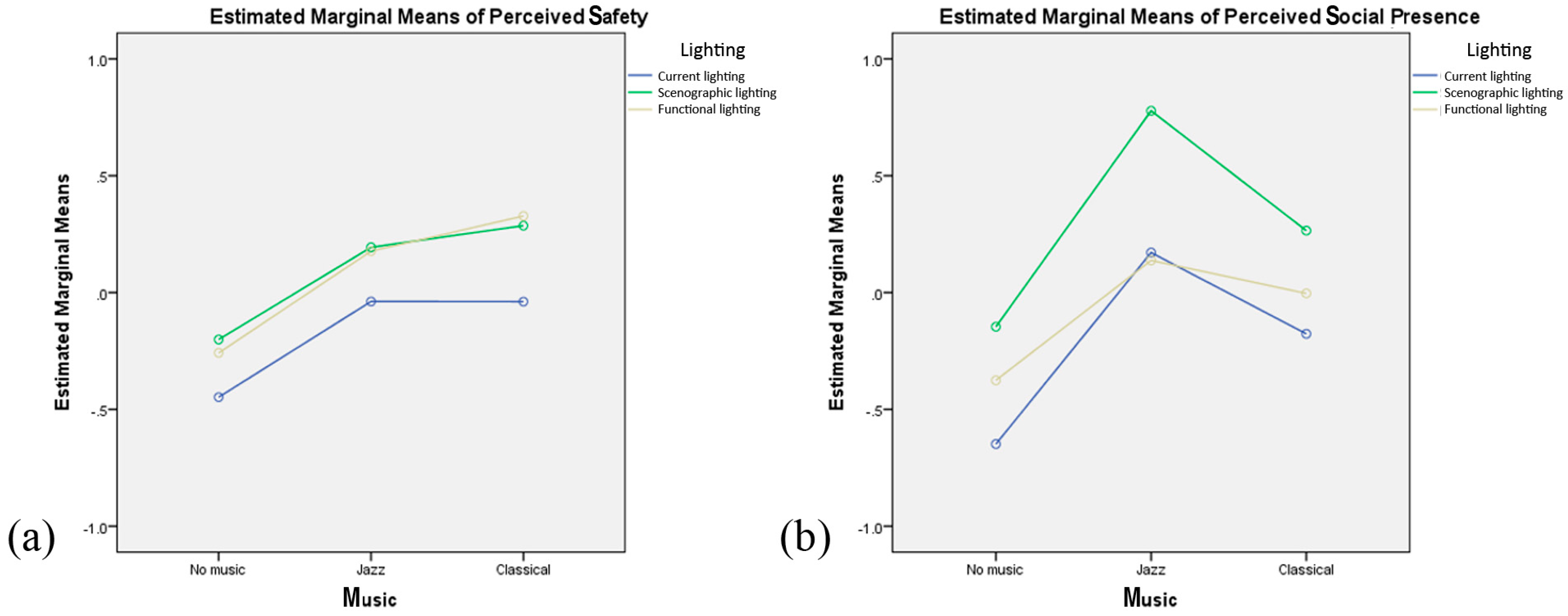
| Parameter | Requirement | Current Situation | Functional Project | Scenographic Project | ||||
|---|---|---|---|---|---|---|---|---|
| EN 13201-2 | P1 | P2 | P1 | P2 | P1 | P2 | ||
| Eav | (lux) | ≥10 | 30 | 26 | 17 | 16 | 17 | 28 |
| Emin | (lux) | ≥3 | 6 | 5 | 9 | 7 | 7 | 14 |
| U | (–) | 0.2 | 0.2 | 0.5 | 0.4 | 0.4 | 0.5 | |
| Esc | (lux) | ≥2 | 9 | 4 | 6 | 4 | 15 | 11 |
| Item | Abbreviation |
|---|---|
| “This area makes me feel worried” | Worried |
| “This area makes me feel tense” | Tense |
| “This area makes me feel comfortable” | Comfortable |
| “This area makes me feel safe” | Safe |
| “This area makes me feel alone” | Alone |
| “This area is a friendly place” | Friendly |
| “This area seems to be alive” | Alive |
| “There is a sense of human warmth in this area” | Human warmth |
| “I feel like there are others in this area” | Presence of others |
| “I feel human sensibility in this area” | Human sensibility |
| Component | ||
|---|---|---|
| 1 | 2 | |
| Worried | −0.880 | −0.061 |
| Tense | −0.879 | −0.137 |
| Comfortable | 0.693 | 0.403 |
| Safe | 0.736 | 0.271 |
| Alone | −0.596 | −0.283 |
| Friendly | 0.626 | 0.593 |
| Alive | 0.560 | 0.664 |
| Human warmth | 0.534 | 0.705 |
| Presence of others | 0.031 | 0.810 |
| Human sensibility | 0.180 | 0.716 |
© 2019 by the authors. Licensee MDPI, Basel, Switzerland. This article is an open access article distributed under the terms and conditions of the Creative Commons Attribution (CC BY) license (http://creativecommons.org/licenses/by/4.0/).
Share and Cite
Calleri, C.; Astolfi, A.; Pellegrino, A.; Aletta, F.; Shtrepi, L.; Bo, E.; Di Stefano, M.; Orecchia, P. The Effect of Soundscapes and Lightscapes on the Perception of Safety and Social Presence Analyzed in a Laboratory Experiment. Sustainability 2019, 11, 3000. https://doi.org/10.3390/su11113000
Calleri C, Astolfi A, Pellegrino A, Aletta F, Shtrepi L, Bo E, Di Stefano M, Orecchia P. The Effect of Soundscapes and Lightscapes on the Perception of Safety and Social Presence Analyzed in a Laboratory Experiment. Sustainability. 2019; 11(11):3000. https://doi.org/10.3390/su11113000
Chicago/Turabian StyleCalleri, Cristina, Arianna Astolfi, Anna Pellegrino, Francesco Aletta, Louena Shtrepi, Elena Bo, Martina Di Stefano, and Paola Orecchia. 2019. "The Effect of Soundscapes and Lightscapes on the Perception of Safety and Social Presence Analyzed in a Laboratory Experiment" Sustainability 11, no. 11: 3000. https://doi.org/10.3390/su11113000
APA StyleCalleri, C., Astolfi, A., Pellegrino, A., Aletta, F., Shtrepi, L., Bo, E., Di Stefano, M., & Orecchia, P. (2019). The Effect of Soundscapes and Lightscapes on the Perception of Safety and Social Presence Analyzed in a Laboratory Experiment. Sustainability, 11(11), 3000. https://doi.org/10.3390/su11113000








